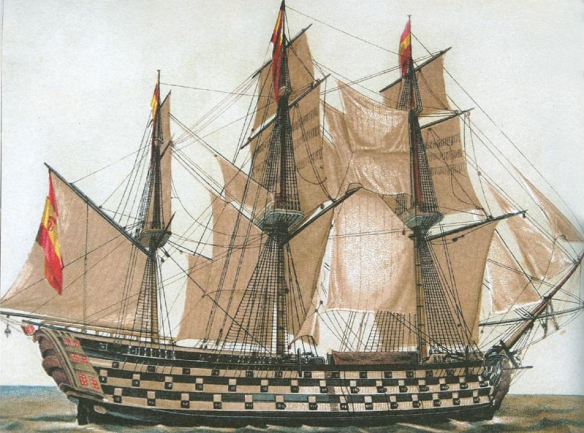112-gun Ship-of-the-Line Santa Anna
The French Revolutionary and Napoleonic Wars witnessed a dramatic transformation in the position of the Spanish Navy. Thus, in 1792 Spain was, on paper at least, one of Europe’s leading naval powers-indeed, Spain’s navy was ranked behind only those of Britain and France-whereas in 1814 the few Spanish warships that still remained could barely be put to sea.
At the beginning of the struggle, however, no one could have predicted this transformation. For most of the eighteenth century, the Spanish Navy had been in the ascendant. Under Charles III, in particular, the number of ships had been greatly expanded, as were Spain’s naval dockyards and other shipbuilding facilities. Meanwhile, Spanish shipbuilders were given the best training available, and their ranks strengthened by imported foreign experts. The training of naval officers was reformed, and a comprehensive system of naval conscription instituted in maritime provinces. In the 1780s, a regular program of fleet maneuvers was instituted. And, above all, money was lavished on the navy: Between 1776 and 1784, for example, spending averaged 28 percent of the national budget.
All this produced an impressive force. Aided not just by rapid naval building but the construction of the many ships built in Cuba from long-lasting colonial hardwoods, in 1792 the navy amounted to 76 ships of the line, 41 frigates, and 109 smaller vessels. Spanish ship design, meanwhile, was excellent: With some exceptions, Spanish warships were immensely strong, eminently sea-worthy, and highly maneuverable, while they had also been growing ever bigger and could carry more guns than British warships of a comparable size. Indeed, the Spanish Navy was the proud owner of the Santisima Trinidad, which was the largest warship in the world and carried 136 guns. And, last but not least, the naval officer corps was first rate: not only had men such as Alejandro Malaspina played a major part in the voyages of exploration and discovery characteristic of the eighteenth century, but commanders such as José de Mazarredo, Federico Gravina, Cosmé Churruca, Dionisio Alcala Galiano, and Cayetano Valdés were widely known for courage and professionalism.
What, then, wrecked the Spanish Navy? According to tradition, the answer lies in the incompetence and corruption endemic in the Spanish administration, and, in particular, the misdeeds of the Spanish royal favorite, Manuel de Godoy. This verdict, however, is unfair. It is certainly true that full-scale naval construction effectively ceased in Spain in 1796, that the Spanish Navy was dogged by a variety of logistical problems, and that every Spanish fleet that put to sea was defeated, but the reasons for this are far more complicated than the “black legend” tends to assume. In the first place, the outbreak of war with France in 1793 completely transformed Spain’s strategic situation. Even though peace was made with the Republic in 1795, and a military alliance forged in 1796, Madrid could no longer depend on Paris’s friendship (as it had been able to do throughout the eighteenth century). With the recent naval expansion only achieved at the cost of the army, which had generally been allowed to run down, a certain reallocation of resources was now inevitable, and all the more so, given the soaring inflation that had gripped Spain since 1780 and was forcing up the cost of construction and maintenance.
Beyond, this, meanwhile, the navy was affected by serious shortages of raw materials. Thus, by the 1790s the oak forests on which shipbuilding in Spain depended had been seriously depleted, while war with Britain from 1796 onward meant that the Baltic pine on which her shipbuilders increasingly relied for masts could not be obtained (initially much pine had come from Mexico, but by the 1790s the most accessible forests had all been cut down there, too). Manpower also was at a premium. Larger ships required larger crews, but the supply of sailors was affected by a series of epidemics of yellow fever that gutted entire communities along the south coast of Spain: between 1803 and 1805, for example, fully 25 percent of the population of Malaga were struck down by this disease.
And, last but not least, war with Britain meant that Spain’s ships were forced to remain cooped up in harbor for long periods, with serious results for both shiphandling and gunnery practice. Though corruption doubtless played its part (along, perhaps, with want of imagination: There was, for example, no attempt to copy the British innovation of supplementing the sailor’s diet with citrus fruit), Spain’s naval decline must therefore be attributed to other issues. Yet decline the Spanish Navy did. Despite great courage and devotion, Spanish fleets were worsted at Cape St. Vincent and Trafalgar, while by 1808 the struggle against Britain had cost 25 men-of-war shipwrecked or lost in battle. As a further 15 had been stricken or broken up since 1792 and still others lost in the war of 1793-1795 or transferred to France, Spain’s striking power had been more than halved, while those ships that remained could hardly put to sea for want of crews, naval stores, and other supplies, the problems experienced in this area being greatly increased by the loss of much of the country to enemy occupation and the complete devastation of the economy. Spanish ships did participate in the Peninsular War, helping, for example, to transport troops around the coast and participating in amphibious operations, but all the while rotting and obsolescent men-of-war were having to be stricken from the service, while others again were lost to shipwreck. For all this destruction there was no replacement, save for a few French ships captured at Cadiz in 1808, and the end result was that by 1814 Spanish naval power was no more.
References and further reading Gardiner, Robert. 2003. Warships of the Napoleonic Era. London: Chatham. Harbron, John. 2004. Trafalgar and the Spanish Navy. London: Conway Maritime. Henry, Chris. 2004. Napoleonic Naval Armaments, 1792-1815. Oxford: Osprey. Pivka, Otto von. 1980. Navies of the Napoleonic Wars. Newton Abbott: David and Charles.
